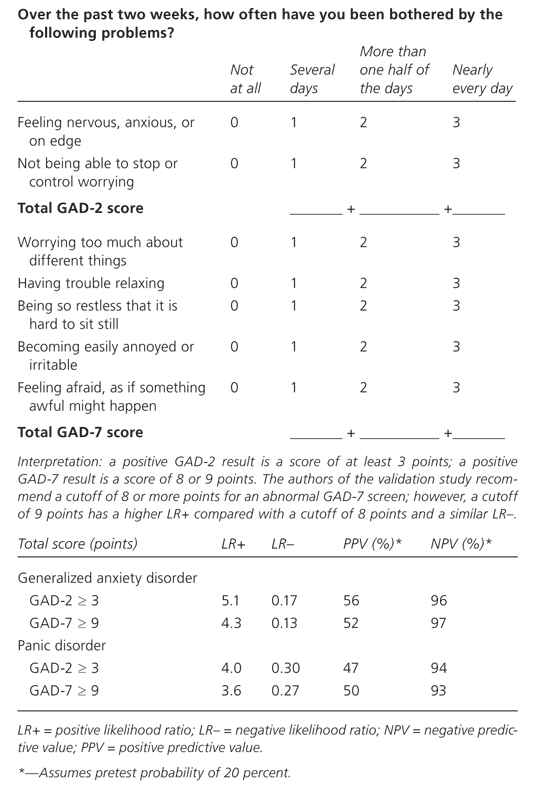
Am Fam Physician. 2008;78(4):501-502
Author disclosure: Nothing to disclose.
Clinical Question
What is the best case-finding tool for anxiety disorders in the primary care setting?
Evidence Summary
Generalized anxiety disorder leads to considerable morbidity and affects approximately 3 percent of patients in primary care practices.1 Social phobia (social anxiety disorder), characterized by a strong fear of social or performance situations that may lead to embarrassment or humiliation, affects 7 percent of primary care patients.2Until recently, there have been few validated tools for evaluating patients for these disorders.
The Hospital Anxiety and Depression Scale is a 14-item tool, primarily used for research in hospital and specialty settings. A limited number of studies have evaluated the tool in the primary care setting and have largely included non-American populations. In addition, the length of this evaluation tool makes it less practical for office-based primary care physicians.3
A brief, three-item version of the 17-item Social Phobia Inventory (SPIN) called the Mini-SPIN (Table 1) was validated in a random sample of 7,165 adults who were given the Mini-SPIN and a screening instrument for depression.4 The researchers identified 344 patients who screened positive for both depression and social phobia; 276 who screened negative for both depression and social phobia; and 397 who screened negative for social phobia, but positive for depression. These 1,017 patients (68 percent women) were given a more detailed telephone interview to confirm the diagnosis of social phobia. Using a cutoff of 6 points or more, the Mini-SPIN was 89 percent sensitive and 90 percent specific in this setting, with positive and negative predictive values of 53 and 98 percent, respectively.
| Rate each of the following items from 0 to 4: | Not at all | A little bit | Somewhat | Very much | Extremely |
|---|---|---|---|---|---|
| Fear of embarrassment causes me to avoid doing things or speaking to people. | 0 | 1 | 2 | 3 | 4 |
| I avoid activities in which I am the center of attention. | 0 | 1 | 2 | 3 | 4 |
| Being embarrassed or looking stupid are among my worst fears. | 0 | 1 | 2 | 3 | 4 |
The seven-item Generalized Anxiety Disorder scale (GAD-7) is a validated diagnostic tool designed for use in the primary care setting. It was developed from an original set of 13 questions and was validated in a group of 965 primary care patients from 15 practices. The validation group answered the 13 questions and participated in a telephone interview conducted by a psychologist or psychiatric social worker, which served as the reference standard.5 The first two questions of the GAD-7 make up the GAD-2, which can be used as an ultra-short diagnostic instrument; both scales and their interpretations are presented in Figure 1.5 Although the GAD-7 was designed to detect generalized anxiety disorder, it is fairly accurate for panic, social anxiety, and posttraumatic stress disorders.

The authors of the validation study recommend a cutoff of 8 or more points for an abnormal GAD-7 result; however, a cutoff of 9 points has a higher positive likelihood ratio compared with a cutoff of 8 points (4.3 versus 3.8, respectively) and a similar negative likelihood ratio.5 The GAD-7 and GAD-2 each have an excellent negative predictive value, but only one half of patients with a positive screen actually have generalized anxiety disorder or panic disorder. Thus, confirmatory interviewing is needed. The GAD-7 has also been validated as a self-administered instrument.6
It is important to note that although the GAD scales are often described as screening instruments, screening for general anxiety disorder and social phobia is not recommended. Instead, these scales are diagnostic instruments used for patients who present with anxiety or anxiety-related symptoms, or when a physician suspects generalized anxiety disorder or social phobia. If the GAD-7 is positive, the physician should perform a more in-depth diagnostic interview to confirm the diagnosis and negotiate the treatment and follow-up strategy with the patient.
Applying the Evidence
A 42-year-old woman presents often with minor or somatic complaints. You wonder if generalized anxiety disorder is an underlying cause for her apparent hypochondriasis.
Answer: The patient reports feeling nervous, anxious, or on edge more than one half of the days of the week and is unable to stop or control her worrying nearly every day, giving her a GAD-2 score of 5 points. On the GAD-7 scale, she answers “several days” to the third, fourth, and sixth questions and “more than one half of the days” to the fifth and seventh questions, giving her a total GAD-7 score of 12 points. Thus, she screens positive for generalized anxiety disorder.